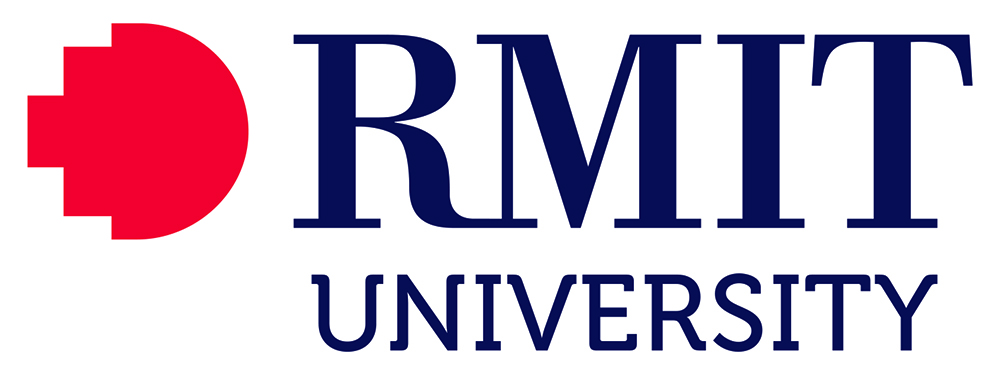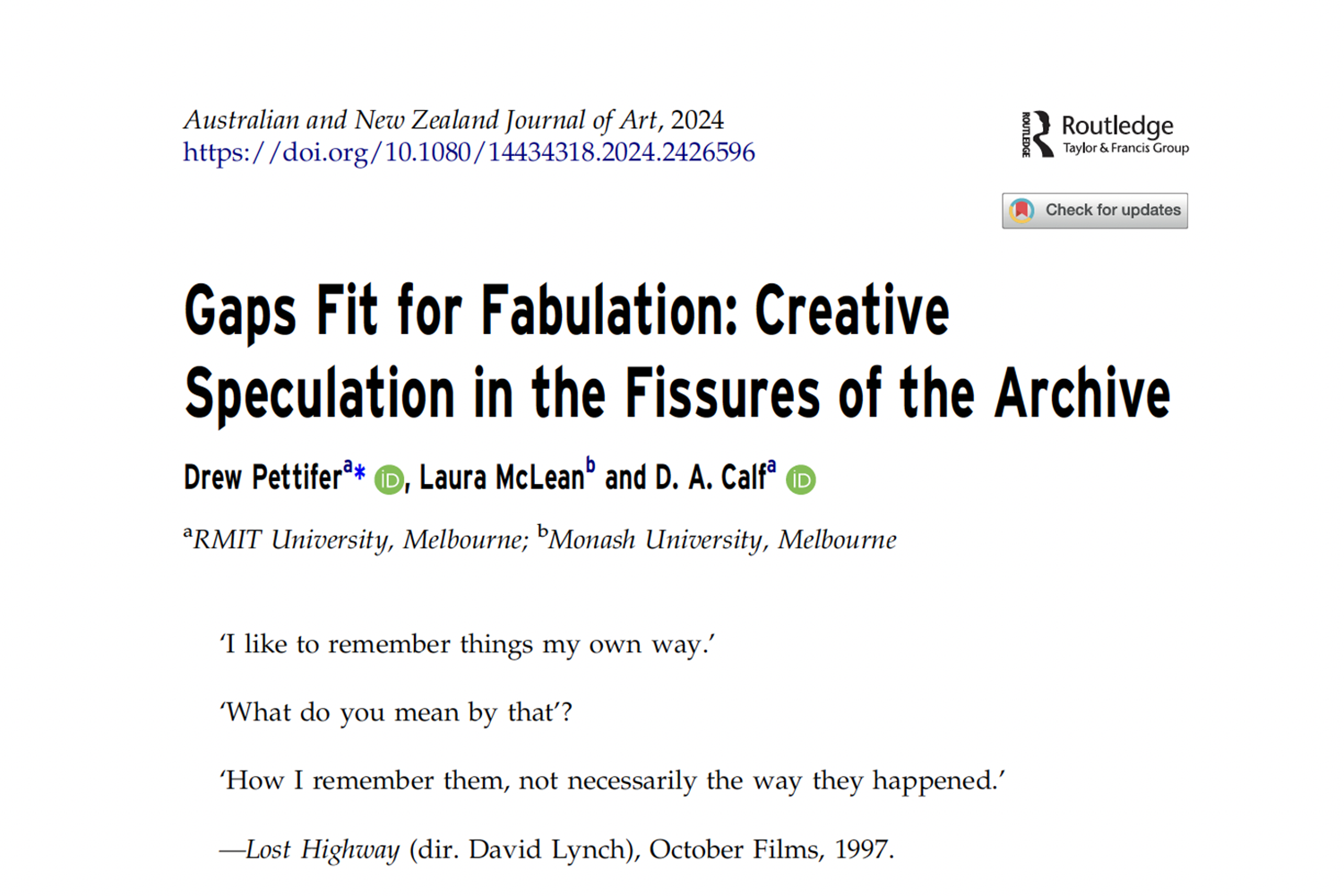Research
Gaps Fit for Fabulation: Creative Speculation in the Fissures of the Archive
Associate Professor Drew Pettifer, sessional lecturer Laura McLean, and sessional lecturer and PhD candidate D A Calf recently published the article Gaps Fit for Fabulation: Creative Speculation in the Fissures of the Archive in the Australian and New Zealand Journal of Art. The paper considers how speculative approaches to the representation of marginalised histories, such as ‘parafiction’ and ‘sonic fictions’, constitute radical forms of recovery addressing ruptures, discontinuities and gaps in the historical record.
Dr Pia Johnson and Dr Clare McCracken
Dr Pia Johnson and Dr Clare McCracken published a chapter in a new cultural geography book Liminality, Transgression and Space Across the World edited by Basak Tanulku and Simone Pekelsma.
The experimental chapter, Liminality When Grounded: Micro-mobilities in contemporary art practice during the COVID-19 pandemic, grew out of Australia’s response to the COVID-19 pandemic. It brings together four artworks by artist-academics Pia Johnson and Clare McCracken made during the first two years of the pandemic. As artist-academics, Pia and Clare are what Natalie Loveless calls ‘maker-thinkers’; through their art forms — photography, performance, creative writing and mixed-media art-making — they make sense of the world and conduct their research. Therefore, the artworks offer a critical lens into the pandemic’s social, cultural and gendered impacts. Grounded in the lived experience of extensive lockdowns, the experimental chapter reveals how Pia and Clare made works intuitively in small snippets of time carved out for themselves as a method to think through the pandemic.
Linda Knight
We would also like to congratulate School of Art affiliate Associate Professor Linda Knight (RMIT) on her 2024 Research Excellence Award — Open. For epitomising RMIT's 'Knowledge with Action' strategy of research and innovation for impact by centralising and pushing the potential of artistic practice to tackle complex challenges and embedding art into projects focused on imaginative and inventive outcomes.
Since 2019, Linda has produced twenty-one peer-reviewed publications (2 books, ten journal papers, eight book chapters, and one review), thirty international creative practice works (20 group and solo exhibitions in Estonia, Australia, USA, NZ, Chile, and ten social art practice works in Finland, Australia, and the USA) and eight research projects totalling approximately $1.5M across category 1, 2, and 3 funding.
Mapping Extinction II, 2023–2024
Through drawing practices, Mapping Extinction II creatively scrapes and translates Big Data on biodiversity and wildwood loss in the UK. The work comments on extractive factors, including capitalism, on ecological precarity. Linda was selected to exhibit in the #TARTU2024 European Festival of Culture program, which took place in Tartu, Estonia, in 2024. Mapping Extinction II was included in 'Missing', 23 August – 6 October, a group show at Tartu Art House, Estonia, with artists Ackroyd & Harvey, Justine Blau, Samuel Collins & Mo Langmuir, Alain Delorme, Katrin Gattinger, Elisa Gleize, Louise Gugi, Jayne Ivimey, Flo Kasearu & Elina Vitola, Diana Lelonek, Fiona Tan, Kristina Ollek & Kert Viiartat.
Kulininpalaju (We Are Listening)
Kulininpalaju is a multi-year partnership between Western Australian organisations Tura and Martumili Artists and the School of Art. Professor Philip Samartzis is the lead sound artist and facilitator of Kulininpalaju working closely with Tura affiliated sound artist Annika Moses over four years to explore the extensive possibilities of collective listening and recording of country and culture in collaboration with Martu artists and communities. Through on-Country creative development Professor Samartzis in consultation with Tura and Martumili Artists has honed a strong methodology for Martu-led intercultural collaboration in the creative sound art medium. This involves mentoring artists in sound recording and production, demonstrating compositional techniques and strategies, undertaking collective sound recording trips, and working cooperatively towards exhibition and performance outcomes.
Professor Samartzis received the RMIT Research Award for Impact and Engagement for his contribution towards Kulininpalaju in recognition for his commitment to promoting respectful and inclusive partnerships, preserving cultural heritage, and encouraging intercultural dialogue and understanding.
Kulininpalaju
Maggie McCormick
Adjunct Professor Maggie McCormick has an article ‘Carto-City to Surface-City: un-mapping and re-mapping the urban emotion of missing’ in Taien Ng-Chan, Nick Lally, Sharon Hayashi (eds), The Commission on Art & Cartography of the International Journal of Cartography, Vol 10. No 2. Taylor & Francis 2024 pp. 211–222.
Museum Dialogues: Exhibiting, Collecting and Activating Photography
Professor Daniel Palmer gave a keynote lecture recently in the United Kingdom: ‘Search as Research, or, from Interface to Book: Activating Photography Collections in Australia’, invited keynote lecture at ‘Museum Dialogues: Exhibiting, Collecting and Activating Photography’, University of Sunderland, UK, 22–24 November 2024.
The paper focused on Dual/Duel a collaborative artist book by Brook Andrew and Trent Walter, with photographs drawn from the State Library of Victoria in Melbourne, and Daniel’s own collaboration with the artist Cherine Fahd at Sydney’s Powerhouse Museum, inspired by the logic of the online search interface.
Professor Daniel Palmer
Professor Daniel Palmer recently edited a special issues of the international journal Media Theory on the topic of 'Seeing Photographically' with co-editors Scott McQuire, Celia Lury, Jasmin Pfefferkorn and Emilie K. Sunde. The essays explore the impact of ‘generative AI’ on the photographic field and the challenges associated with theorizing photography. Palmer has an essay in the special issue co-written with Katrina Sluis from ANU titled 'The Automation of Style: Seeing Photographically in Generative AI'. Media Theory is an open access journal which means that all content is freely available without charge.
Phantasms for Future Ecologies
Tai Kok Tsui, Hong Kong, January & July 2025
In partnership between the Hong Kong Arts Centre
Phantasms for Future Ecologies is a public artwork in the neighbourhood of Tai Kok Tsui comprising of a digital public artwork of local urban animals by Mikala Dwyer (January 2025), a community engaged ‘citizen-artist’ workshop for local youth by Tammy Wong Hulbert (January 2025) and a symposium on ‘Art and Future Ecologies’ by Kristen Sharp (June 2025).
This project is part of a broader urban renewal project led by Hong Kong Art Centre 'RE: Tai Kok Tsui' which considers how public art can connect local communities to place and heritage, stimulating dialogue and discussion about living sustainably. Phantasms will build opportunities for exchange between researchers at the Hong Kong Arts Centre (HKAC), RMIT University and evolving communities in Tai Kok Tsui, to build mutual understandings of sustainable urban futures. The Australian team were awarded an Australian Cultural Diplomacy Grant (2023–4) funding from the Department of Foreign Affairs and Trade to support the development of this project.
Professor Kit Wise
Dean, RMIT School of Art Professor Kit Wise was an invited speaker at the Australian Institute of Sport 2024 Performance Teams Forum in October 2024.
The inaugural Performance Teams Forum aimed to address a clear objective in our HP2032+ strategy, exploring what world-leading knowledge and practice looks like for integrated, high-functioning Performance Teams.


